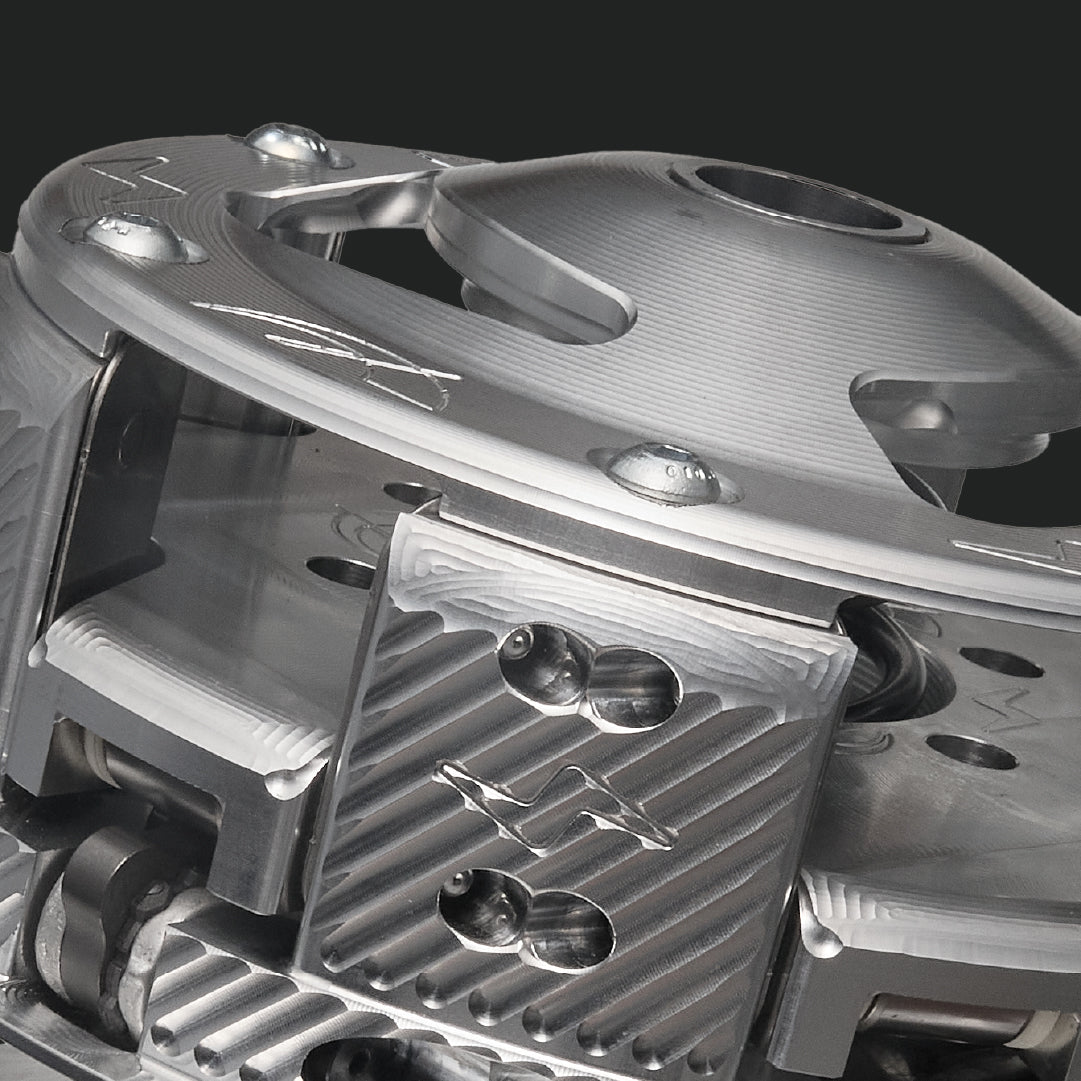If you don't clean your UTV clutch system regularly, you’re sacrificing power and inviting failure.
Your CVT clutch system is the heart of your UTV’s drivetrain, and it’s working overtime every time you hit the trail, the dunes, or the mud pit. Over time, belt dust, grit, and debris build up inside the clutch housing, choking performance and putting massive strain on your belt and sheaves.
Ignore it, and you’ll start to feel the effects—slip, heat, noise, and eventually, a destroyed clutch or belt.
Clutch cleaning isn’t just maintenance—it’s performance insurance. In this guide, we’ll show you how to properly clean your UTV’s primary, secondary, and belt systems to keep your machine running strong, avoid breakdowns, and get the most out of every ride.

Understanding the Clutch System
If you own a UTV, your clutch system isn’t just important—it’s everything.
UTVs run a CVT (Continuously Variable Transmission) that relies on three critical components: the Primary Clutch, Secondary Clutch, and Drive Belt. These parts work together to deliver smooth, efficient power from your engine to the wheels. But when they’re packed with mud, dust, or belt debris, performance drops fast.
Primary Clutch (Drive Clutch)
This clutch is mounted to the engine crankshaft. It responds to engine RPM by closing its sheaves and gripping the belt to engage power. If the sheaves are glazed with belt residue or packed with grit, shift-out becomes sloppy, and you lose efficiency under load. Worse yet, it puts your belt at serious risk.
Secondary Clutch (Driven Clutch)
This is connected to your transmission input. Its job is to react to the primary clutch and maintain proper belt tension, especially under varying loads. When it’s dirty or not moving freely, you’ll notice sluggish backshift, poor throttle response, and excessive belt wear, especially during technical, low-speed terrain like deep mud or rock.
Drive Belt
The belt is the lifeline between your clutches. It takes a beating every ride, especially if your clutches aren’t clean. When debris builds up, your belt doesn’t grip properly, causing it to slip, heat up, and eventually fail. That failure often takes out other components with it.
In a UTV, the CVT system is constantly working—even when you’re idling or crawling through the muck. If your clutch components are dirty, worn, or misaligned, you’re not just losing performance—you’re shortening the life of your entire drivetrain.
Signs That Your Clutch Needs Cleaning
A dirty clutch won’t just cost you performance—it’ll eventually cost you parts.
Because your UTV’s CVT system is always working—especially in high-load environments like mud, sand, or technical trails—buildup inside the clutch housing happens fast. If you’re not regularly cleaning your primary, secondary, and belt area, your machine will let you know.
Here are the most common signs your clutch is overdue for a deep clean:
1. Slipping Belt
One of the first red flags. If you hit the throttle and the engine revs up without the UTV accelerating like it should, chances are your belt is slipping on dirty or glazed sheaves.
2. Difficulty Backshifting
If your UTV feels sluggish after you decelerate—like it takes too long to get back into the power—it could be a sign your secondary clutch is binding due to dust or debris.
3. Unusual Noises
Squeaking, squealing, or clunking from the clutch area? That could be belt slip, sheave contamination, or a dry bearing—all symptoms of a clutch system that needs attention.
4. Vibrations or Jerky Engagement
Dirty sheaves and belt residue can cause uneven engagement, which you’ll feel as vibration, shuddering, or jerky takeoff when rolling into the throttle.
5. Overheating Belts
Hot belt smell after a short ride? Belt dust and grime reduce grip, causing excessive slip and heat. Left unchecked, this leads to belt blowouts or even damaged sheaves.
If you’re seeing any of these symptoms, it’s time to get into your clutch housing and clean it out before you wreck your setup.
Step-by-Step Guide to Clutch Cleaning
If your UTV clutch is slipping, jerky, or making noise, it’s time to clean it. Here’s how to properly clean your CVT clutch system and get it back in top shape. No guesswork—just the right process to protect your performance parts and belt life.
1. Prepare the Vehicle
-
Remove the clutch cover carefully—don’t lose the screws or damage the seal.
-
Inspect the inside of the housing for excess belt dust, mud, or debris.
2. Inspect the Belt
-
Look for glazing, cracks, missing cogs, or discoloration.
-
If your belt shows any of these signs, replace it immediately.
-
If it’s still in good shape, clean it using warm soapy water, rinse thoroughly, and let it dry completely.
3. Clean the Primary Clutch
-
Wipe down the sheaves (belt surfaces) using a clean, lint-free cloth and brake cleaner.
-
You can use maroon Scotch-Brite to clean up the sheave surfaces—just enough to remove belt glaze or residue.
-
Check rollers and bushings for smooth movement and inspect for flat spots or excessive wear.
4. Clean the Secondary Clutch
-
Repeat the cleaning process as you did with the primary.
-
Pay close attention to the helix area and shaft splines.
-
Use brake cleaner only—no lube.
5. Inspect and Clean the Clutch Housing
-
Remove all dust, debris, or moisture inside the housing.
-
A damp microfiber cloth works best for wiping everything down.
-
If water has been in the housing, dry it completely and inspect for rust or wear.
6. Reassemble and Reinstall
-
Ensure everything is clean and dry before reassembling.
-
Reinstall the belt, carefully aligning it on the sheaves.
-
Reattach the clutch cover and double-check the seal.
Pro Tip: After a full cleaning, run your UTV in low gear and light throttle for a few minutes to reseat the belt and monitor how the clutch responds.
Maintenance Tips for Prolonged Clutch Life
Cleaning your clutch is important, but how you ride and maintain your UTV between cleanings is what really determines how long your clutch components last. Here are proven tips to extend the life of your CVT system and keep performance at its peak:
1. Avoid Riding the Clutch
Stay off the throttle unless you’re moving. Riding the clutch at low RPM for too long creates heat, wears the belt, and destroys the sheave surfaces over time. Be intentional with throttle input.
2. Shift Smoothly and Deliberately
Don’t force the shifter. Whether you’re going from park to low or low to high, always let the vehicle come to a complete stop before shifting. Slamming gears under load puts unnecessary stress on both clutches and your belt.
3. Inspect Regularly
After every few hard rides, pull your clutch cover and inspect for belt dust, glazing, or debris. It takes just a few minutes, and it could save you from a failed belt or toasted sheave on your next ride.
4. Use High-Quality Belts and Components
Not all belts are created equal. Stick to OEM belts or trusted high-performance aftermarket options designed to hold up under heat, load, and aggressive riding. Cheap belts shred fast and destroy clutch surfaces.
5. Recalibrate When You Modify
If you change tire size, install portals, or alter gearing, your clutching is no longer optimized. Make sure to recalibrate your clutch setup with the right weights, springs, and helix profile. A poorly tuned clutch kills performance and belt life.
6. Store It Right
If your UTV sits for long periods, clean the clutch system first. Store it in a dry environment to prevent condensation and corrosion inside the clutch housing.
Bottom line: Keep it clean, keep it tuned, and your clutch will keep delivering the power you need—ride after ride.
When to Seek Professional Help
Some clutch problems can’t be fixed with a simple cleaning, and knowing when to stop and call in the pros can save you from serious downtime and expensive repairs.
Here’s when it’s time to reach out for expert clutch service:
1. Ongoing Belt Slippage or Poor Performance
If you’ve cleaned everything and you’re still getting belt slip, loss of power, or poor throttle response, your clutch calibration may be off, or there could be internal wear that requires attention.
2. Loud or Irregular Noises
Grinding, squealing, or knocking sounds after cleaning usually point to worn bushings, rollers, or bearings inside the primary or secondary. These are wear components—and they need to be replaced, not ignored.
3. Visible Damage to Clutch Sheaves
If your sheaves have deep grooves, pitting, or excessive glazing that doesn’t clean up with Scotch-Brite, they’re likely beyond serviceable. Riding on damaged sheaves can shred belts and ruin other components fast.
4. Water Intrusion or Mud Inside the Housing
If your clutch housing has taken on water or thick mud, there may already be hidden corrosion, bearing damage, or belt contamination. The longer it sits, the worse it gets.
If you’re seeing these signs, don’t guess—reach out to the experts at KWI Clutching. We’ll get you back to peak performance with proven parts, professional calibration, and the tech support to back it all up.
Contact us here for clutch support, service advice, or help choosing the right setup.
Conclusion
If you want your UTV to perform like it should, clutch cleaning isn’t optional—it’s mandatory.
Mud, belt dust, and debris build up fast, especially when you’re pushing your machine in the conditions it was built for. A dirty clutch system leads to slipping, heat, wear, and—eventually—breakdowns. But with the right cleaning routine and a few smart habits, you can protect your belt, extend the life of your clutches, and keep your UTV running hard every time you ride.
Need help choosing parts or dialing in your setup after a cleaning? Check out our Can-Am Clutch Kits and RZR Clutch Kits!
Reach out to KWI Clutching — we’ll make sure you’re tuned right and ready for the ride.
Keep it clean. Keep it calibrated. Keep it KWI.
Related Articles


Share:
Riley Binnquist Takes the Win at King Shocks Battle at Primm Running KWI’s Ultrashift X3 Pro Aggressive Clutch Package
AO-RC Clutch Kit: Precision Performance for Rock Crawling